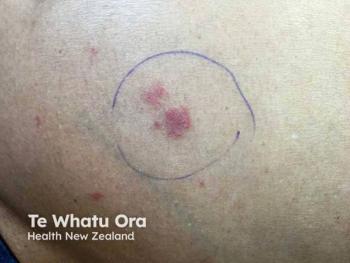
Management of Patients with AD on Dupilumab
A recent study investigated practical issues related to the use of dupilumab for atopic dermatitis.
Dupilumab (Dupixent; Sanofi and Regeneron) is approved to treat moderate to severe atopic dermatitis (AD) in patients 6 years and older. Practical management issues have been a concern since its approval including transitioning from current therapies and managing medication overlap, considerations for special populations of patients with AD, and management of potential adverse events (AEs) such as conjunctivitis and facial rashes. In response to these issues, a study in Dermatology and Therapy aimed to provide a review of the current evidence and opinions from a panel of dermatologists in AD relative to the practical use of dupilumab.
The panel was made of 12 board-certified dermatologists from Canada with up to 40 years of clinical and research experience. The panel discussed:
- Practical management issues and special populations relative to dupilumab use in AD;
- agreed upon topics for review and practical consideration;
- conducted an unstructured review of recent literature;
- identified points of uncertainty; and
- provided practical recommendations for dupilumab use based on both the available literature and clinical expertise.
As there was no data collected for this work, institutional ethics approvals were not required.
All the panel authors reviewed each summary draft statement prior to voting and responses were collated with revisions applied, followed by a round of anonymous voting indicating level of agreement for each statement on a scale of 0–100%, and degree of uncertainty for each statement. Panelists then evaluated each statement based on a combination of assessment of the available literature as well as clinical opinion. Abstaining from voting was not permitted.
Individual responses were represented as beta distributions in the supplementary appendix along with consolidated estimates and Bayesian distributions, the article continued.
Treatment Initiation and Maintenance
Dosing for adults and pediatric patients weighing 60 kg or less consists of 600 mg loading dose (LD) followed by 300 mg every other week (q2w) for AD, according to the article. Pediatric dosing for patients greater than 60 kg is weight-based, consisting of either 600 mg LD followed by 300 mg every 4 weeks (q4w) for patients 15 to more than 30 kg, or 400 mg LD followed by 200 mg q2w for patients 30 to more than 60 kg in Canada and the US.
Statement 1.1.1
Concurrent treatment with traditional systemic therapy and dupilumab does not alter either drug’s intrinsic risk profile. Bayesian estimate of support (95% credibility interval): 97.8% (97.1–98.2%).
Statement 1.1.2
When initiating dupilumab, concurrent systemic therapies may be tapered according to clinical response following dupilumab introduction, except in cases of adverse event or intolerance to traditional systemic agent necessitating withdrawal as abruptly as permitted relative to the safety issue. 98.6% (98.3–99.3%).
Statement 1.2.1
For patients with adequate clinical response to dupilumab, continued use at the approved dose regimen will provide optimal long-term benefit, unless PROs fail to improve. 96.2% (95.4–96.9%).
Statement 1.2.2
For patients who do not achieve clinical improvement in AD by week 16–24, re-evaluation of diagnosis and alternative treatment may improve outcome. 98.4% (97.4–98.8%).
Statement 1.3.1
Increasing to weekly dosing may be considered in patients with partial or non-durable response to dupilumab. 92.7% (90.0–94.9%).
Statement 1.3.2
For patients not achieving adequate response on dupilumab, the addition of a traditional systemic agent may provide benefit. 98.3% (97.3–98.7%).
Special Populations in AD
Many special considerations in treating AD for special populations are typically excluded from clinical trials. “Many traditional systemic medications have known drug-drug interactions, which is a concern in patients where polypharmacy is already an issue,” authors wrote. “These include, but are not limited to, older adults, patients with organ transplants, and patients receiving antiretroviral medications for HIV.”
Statement 2.1.1
Dupilumab exposure during pregnancy poses little risk to mother and fetus. 89.9% (86.3–92.9%).
Statement 2.1.2
There is negligible absorption of dupilumab by infants who are breast fed by women taking dupilumab. 97.0% (96.1–97.9%).
Statement 2.2.1
There is no known additional risk in treating patients with prior malignancy and most active malignancies with dupilumab. Exclusion of CTCL prior to dupilumab initiation is an important safety consideration. 92.7% (90.1–94.9%).
Statement 2.3.1
Dupilumab is unlikely to increase risks associated with pre-existing immune disorders including patients with HIV, patients with HIES, and organ transplant recipients. Drug-drug interactions are an important consideration when using traditional systemic agents in patients with pre-existing immune disorders. 95.6% (94.2–97.0%).
Statement 2.4.1
Dupilumab has no additive safety concerns in older patients with AD and should be considered preferential to traditional systemic agents where contraindications, polypharmacy, and co-existing conditions complicate their use. 95.2% (94.0–96.8%).
Statement 2.4.2
A confirmed diagnosis of AD in older adults with atypical presentation, especially to rule out CTCL, is crucial before initiating any systemic therapy, including dupilumab. 95.8% (94.9–96.9%).
Statement 2.5.1
Dupilumab may be continued in patients with COVID-19. 91.7% (88.8–94.1%).
Statement 2.5.2
Dupilumab is unlikely to impact COVID-19 vaccine effectiveness and is not associated with additional safety risk. 92.8% (89.2–95.5%).
Management of Potential Adverse Events in Patients on Dupilumab for AD
While dupilumab has been associated with improvements in AD and quality of life for patients with the skin condition, some AEs has been noted such as conjunctivitis, recalcitrant head and neck dermatitis, psoriasiform eruptions, and arthritic conditions, the article explained.
Statement 3.1.1
Prophylactic measures such as artificial tears may reduce the incidence of conjunctivitis in patients with AD taking dupilumab. 92.8% (92.0–94.1%).
Statement 3.2.1
Dupilumab-associated recalcitrant head and neck dermatitis may respond to short courses of low- to mid-potency topical steroids, topical calcineurin inhibitors and/or topical ketoconazole without dupilumab interruption. 98.4% (98.2–99.1%).
Statement 3.2.2
A short course of itraconazole or adjunct systemic therapy has provided benefit in some patients not responding to topical therapy. 81.8% (75.8–87.0%).
Statement 3.3.1
Psoriasiform eruption has been reported in patients receiving dupilumab for AD. Most cases are localized and can be managed with topical anti-psoriatic therapy without dupilumab discontinuation. 85.7% (80.3–90.2%).
Statement 3.4.1
Arthrosis and arthralgia are rare in patients receiving dupilumab, and their association with dupilumab therapy is uncertain. 86.7% (82.9–90.0%).
Reference:
Papp KA, Hong C ho, Lansang MP, et al. Practical management of patients with atopic dermatitis on dupilumab. Dermatol Ther (Heidelb). 2021;11(5):1805-1828. doi:10.1007/s13555-021-00586-w
Newsletter
Like what you’re reading? Subscribe to Dermatology Times for weekly updates on therapies, innovations, and real-world practice tips.


















